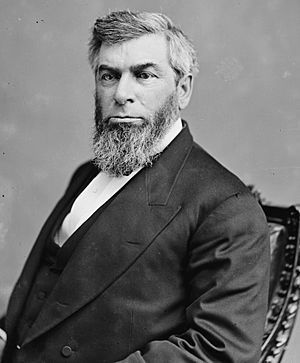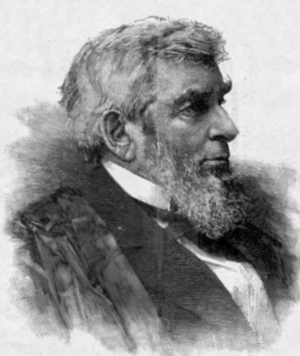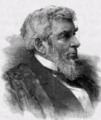Morrison Waite facts for kids
Quick facts for kids
Morrison Waite
|
|
|---|---|

Portrait, c. 1870—1880
|
|
| 7th Chief Justice of the United States | |
| In office March 4, 1874 – March 23, 1888 |
|
| Nominated by | Ulysses S. Grant |
| Preceded by | Salmon P. Chase |
| Succeeded by | Melville Fuller |
| Personal details | |
| Born |
Morrison Remick Waite
November 29, 1816 Lyme, Connecticut, U.S. |
| Died | March 23, 1888 (aged 71) Washington, D.C., U.S. |
| Resting place | Woodlawn Cemetery |
| Political party |
|
| Spouse |
Amelia Champlin Warner
(m. 1840) |
| Children | 4 |
| Education | Yale College (BA) |
| Signature | |
Morrison Remick Waite (born November 29, 1816 – died March 23, 1888) was an important American lawyer and judge from Ohio. He became the seventh Chief Justice of the United States in 1874 and served until his death in 1888.
During his time as Chief Justice, the Supreme Court, led by Waite, looked closely at laws passed after the American Civil War. These laws, from the Reconstruction Era, aimed to give more rights to formerly enslaved people, known as freedmen. The court often interpreted these laws in a way that limited the power of the federal government.
Born in Lyme, Connecticut, Waite started his law career in Toledo, Ohio, after finishing college at Yale University. He was a member of the Whig Party and later helped create the Ohio Republican Party. He also worked as a lawyer for the U.S. government in an important international case called the Alabama Claims.
After the previous Chief Justice, Salmon P. Chase, passed away, President Ulysses S. Grant chose Waite for the job. Even though some politicians didn't know much about him, the Senate approved him quickly. Waite believed the Supreme Court was too important to be a stepping stone to other political jobs, so he didn't run for president. He served on the court until he died from pneumonia in 1888.
Waite was known for being a good leader and helping the judges work well together. He tried to balance power between the federal government and the states. His decisions in cases like Munn v. Illinois helped shape how the government could regulate businesses. However, he also agreed with decisions that limited the rights of African Americans, which were later changed by new laws.
Contents
Early Life and Education
Morrison Remick Waite was born on November 29, 1816, in Lyme, Connecticut. His father, Henry Matson Waite, was also a lawyer and later became a judge.
Morrison went to Bacon Academy and then to Yale College, graduating in 1837. After college, he started studying law with his father. Soon after, he moved to Maumee, Ohio, to continue his law studies. He became a lawyer in 1839 and started his own law practice. He even served one term as the mayor of Maumee.
Family Life
Morrison Waite married Amelia Champlin Warner on September 21, 1840. They had four children: three sons named Henry Seldon, Christopher Champlin, and Edward Tinker, and a daughter named Mary Frances Waite.
Political and Legal Career
In 1850, Waite and his family moved to Toledo. There, he became a very respected lawyer. He was elected to the Ohio Senate in 1849. He also tried twice to become a U.S. Senator but didn't win.
Because he was against slavery, Waite joined the new Republican Party in the mid-1850s. By 1870, he was known as one of the best lawyers in Ohio.
In 1871, Waite was chosen to represent the United States in an important international case called the Alabama Claims. This case was about ships built in Britain that helped the Confederate side during the American Civil War. Waite helped the U.S. win $15 million in this case, which made him well-known across the country. In 1872, he was chosen to lead the Ohio constitutional convention.
Becoming Chief Justice of the United States
President Ulysses S. Grant nominated Morrison Waite to be Chief Justice on January 19, 1874. The position had been open for a while after Chief Justice Salmon P. Chase died in May 1873. President Grant had offered the job to several other people first, but they all turned it down or faced problems getting approved.
Finally, after people from Ohio suggested Waite, Grant nominated him. Many politicians didn't know much about Waite, but people across the country were happy that a calm and capable person was chosen. The Senate quickly approved him without any votes against him on January 21, 1874. Waite officially started his job on March 4, 1874.
Leading the Supreme Court

As Chief Justice, Waite was not known for having the most brilliant legal ideas, but he was excellent at managing the court. He was good-humored and sensitive to others, which helped the judges work together smoothly. During his time, the Supreme Court decided about 3,470 cases. Waite was very hardworking and wrote about one-third of these decisions himself.
He believed that the federal government had broad power to regulate businesses, especially when they affected the public. He also focused on balancing the power between the federal government and the states.
After the American Civil War and Reconstruction, many cases involved new amendments (the 13th, 14th, and 15th) that aimed to protect the rights of African Americans. Waite and the court often interpreted these amendments in a way that gave less power to the federal government to enforce them.
For example, in the case of United States v. Cruikshank, the court decided that states were responsible for protecting citizens from attacks by other private citizens. This meant the federal government couldn't punish people who committed violence against African Americans, even in terrible events like the Colfax massacre. Waite believed that white leaders in the South should set the rules for race relations. However, in reality, many Southern states did not protect African Americans, leading to unfair laws and violence.
Waite also supported the states' right to prevent women from voting in Minor v. Happersett (1875). However, he did support women being allowed to become lawyers in the Supreme Court.
In Munn v. Illinois (1877), Waite wrote an important opinion. The court ruled that when a business, like a grain elevator or railroad, affects the public, the government can regulate its prices. This decision was a big step in allowing governments to regulate businesses and was important for future laws, like those during the New Deal.
Waite refused to run for president in 1876, even though some people thought he would be a good candidate. He said his job was to keep the Supreme Court pure and honorable, not to use it as a step to a higher office. As Chief Justice, Waite swore in four presidents: Rutherford Hayes, James Garfield, Chester A. Arthur, and Grover Cleveland. He worked hard until his death.
Death and Legacy
Morrison Waite died suddenly from pneumonia on March 23, 1888. His death was a surprise in Washington, D.C., as his illness had been kept private. Many people attended his funeral, and most of the Supreme Court justices traveled with his body to Toledo, Ohio. He was buried in Woodlawn Cemetery in Toledo.
Waite did not have much money when he died, so lawyers in Washington and New York raised funds to help his wife and daughters.
Today, Waite High School (Toledo, Ohio) is named in his honor.
Images for kids
-
Waite's portrait as in Harper's Weekly, 1890
See also
- Corporate personhood
- List of justices of the Supreme Court of the United States
- List of United States Supreme Court justices by time in office
- List of United States Supreme Court cases by the Waite Court




